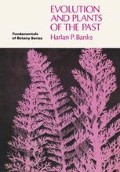Abstract
In Chapter 2 we saw that several lines of indirect evidence point to the existence of plants from some 3 billion years ago. It is necessary now to look into the more direct evidence that can be provided only by fossils of the plants themselves. This evidence, if forthcoming, would substantiate the biogeochemical data presented earlier. Until recent years it has been generally accepted that many Precambrian rocks were highly metamorphosed and devoid of fossils. From time to time bacteria or various macrofossils have been reported, but none gained wide acceptance. A recent review of Precambrian animal records indicates that all are extremely dubious. However, commencing with the first report of microorganisms in the Gunflint chert in southwestern Ontario, both the evidence for Precambrian plants and the belief in their authenticity have increased remarkably. New physical, chemical, and microscopical techniques have aided the study of fossils, and space research and chemical experiments on the origin of life have led many investigators to accept such discoveries.
Preview
Unable to display preview. Download preview PDF.
Suggestions for Further Reading
Barghoorn, E. S., and J. W. Schopf, “Microorganisms from the Late Precambrian of Central Australia,” Science, 150 (1965), pp. 337–339.
Barghoorn, E. S., and J. W. Schopf, “Microorganisms Three Billion Years Old From the Precambrian of South Africa,” Science, 152 (1966), pp. 758–763. Discusses the oldest organisms preserved as fossils.
Barghoorn, E. S., and S. A. Tyler, “Microorganisms from the Gunflint Chert,” Science, 147 (1965), pp. 563–577. Descriptions and illustrations of two billion year old organisms in the Gunflint Chert.
Baschnagel, R. A., “New Fossil Algae from the Middle Devonian of New York,” Transactions of the American Microscopical Society, 85 (1966), pp. 297–302. Discusses green algae in the Devonian.
Cloud, P. E., Jr., “Significance of the Gunflint (Precambrian) Microflora,” Science, 148 (1965), pp. 27–35.
Croft,.W. N., “A new Trochiliscus (Charophyta) from the Downtonian of Podolia,” British Museum (Natural History) Geology Bulletin, I (1952), pp. 189–220.
Croft, W. N., and E. A. George, “Blue-green Algae from the Middle Devonian of Rhynie, Aberdeenshire,” British Museum (Natural History) Geology Bulletin, 3 (1959), pp. 341–353. Shows beautifully preserved, highly evolved blue-green algae in Devonian.
Fritsch, F. E., “Studies in the Comparative Morphology of the Algae. IV. Algae and Archegoniate Plants,” Annals of Botany, New Series, 9 (1945), pp. 1–29. Explains the hypothesis that land plants originated from algae.
Johnson, J. H., and K. Konishi, “Studies of Devonian Algae,” Quarterly of the Colorado School of Mines, 53 (1958), pp. 1–114. This is one of a series of reviews of Paleozoic algae published in the same journal by Johnson.
Kesling, R. V., and A. Graham, “Ischadites is a Dasycladacean Alga,” Journal of Paleontology, 36 (1962), pp. 943–952.
Kidston, R., and W. H. Lang, “On Old Red Sandstone Plants Showing Structure, from the Rhynie Chert Bed, Aberdeenshire, Part 5,” Transactions of the Royal Society of Edinburgh, 52 (1921), pp. 855–902. Final paper on famous plants from Rhynie.
Lang, W. H., “On the Plant-Remains from the Downtonian of England and Wales,” Philosophical Transactions of the Royal Society of London B 227 (1937), pp. 245–291. Includes details of Cooksonia the oldest vascular plant.
Logan, Brian, “Cryptozoon and Associate Stromatolites from the Recent, Shark Bay, Western Australia,” Journal of Geology, 69 (1961), pp. 517–533. Descriptions and illustrations of modern stromatolites.
Pflug, H. D., “Foraminiferen und Ähnlichen Fossilreste aus dem Kambrium und Algonkium,” Palaeontographica A 125 (1965), pp. 46–60. Discusses possibly the oldest protozoans.
Schopf, J. W., “Antiquity and Evolution of Precambrian Life,” in McGraw-Hill Yearbook of Science and Technology (New York: McGraw-Hill Book Co., Inc., 1967), pp. 47–55. A short, good account of early life.
Schopf, J. W., “Microflora of the Bitter Springs Formation, Late Precambrian, Central Australia,” Journal of Paleontology, 42 (1968), pp. 651–688. Discusses first green algae and nuclei.
Schopf, J. W., and E. S. Barghoorn, “Alga-Like Fossils from the Early Precambrian of South Africa,” Science, 156 (1967), pp. 508–512.
Schopf, J. W., E. S. Barghoorn, M. D. Maser, and R. O. Gordon, “Electron Microscopy of Fossil Bacteria Two Billion Years Old,” Science, 149 (1965), pp. 1365–1367.
Siegel, S. M., and C. Giumarro, “On the Culture of a Microorganism Similar to the Precambrian Microfossil Kakebekia umbellata Barghoorn in NH3-rich Atmospheres,” Proceedings of the National Academy of Sciences, 55 (1966), pp. 349–353.
Author information
Authors and Affiliations
Copyright information
© 1970 Wadsworth Publishing Company, Inc.
About this chapter
Cite this chapter
Banks, H.P. (1970). Early Plant Life — the Thallophytes. In: Evolution and Plants of the Past. Fundamentals of Botany Series. Palgrave, London. https://doi.org/10.1007/978-1-349-01818-5_3
Download citation
DOI: https://doi.org/10.1007/978-1-349-01818-5_3
Publisher Name: Palgrave, London
Print ISBN: 978-0-333-14634-7
Online ISBN: 978-1-349-01818-5
eBook Packages: Biomedical and Life SciencesBiomedical and Life Sciences (R0)

